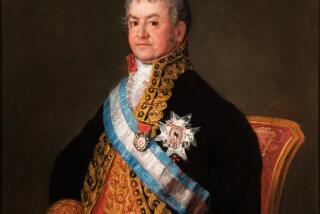Getty’s Peter Paul Rubens work is subject of intrigue
- Share via
A picture may be worth a thousand words, but this one has inspired many more, because it has become a departure point for how Europeans became acquainted with Asia.
When the Getty acquired an 17th century drawing by Flemish artist Peter Paul Rubens, “Man in Korean Costume,” at a 1983 auction, it was already well known among the cognoscenti. Then six years ago Getty curator Stephanie Schrader learned that it had inspired two books in Korea — a bestselling novel in 1993 and a nonfiction volume by a Jesuit historian in 2004.
“I thought we should do a little more research,” Schrader says. “Perhaps I was a bit naive, but I never knew how complicated it would be.” The two-gallery exhibition which just opened — “Looking East: Rubens’s Encounter with Asia” (through June 9) — shows how she managed to unpack the back story of this drawing, probably made in 1617, and how it fits into a pivotal moment in East-West contact.
PHOTOS: Arts and culture in pictures by The Times
Rendered in black chalk with red highlights on his lips, cheeks, nose and ears, the subject is a man in a voluminous robe and wearing an unusual transparent hat that reveals a topknot underneath. He looks out at the viewer with a friendly, inquiring look, with a face that is vaguely but not definitively Asian. “That direct gaze,” says Schrader, “it grabs people.” The background is unfinished, and a sketchy merchant ship at lower left suggests maritime trade and travel.
Rubens was arguably the most celebrated painter of his time, patronized by monarchs and the Catholic Church. He drew as a form of note taking, and sometimes details from drawings would reappear in his paintings. Later the “Korean man,” or at least his costume, would appear in his painting “The Miracles of St. Francis Xavier” done for the Jesuits. (The “modello,” or preparatory painting, for this is in the exhibition.)
But did Rubens ever meet a Korean man? Schrader thinks not but says that he might have met Jesuits who brought Korean garb back from their missionary expeditions to China.
FULL COVERAGE: 2013 Spring arts preview
Europeans had discovered China and Japan by 1617 and had made contact through Jesuit priests eager for Asian converts, but there was almost no contact with Korea. An underlying theme of the show is cultural perceptions and misperceptions. Just as Edward Said argued in his landmark book, “Orientalism,” there was a long-standing tendency by Europeans to exoticize “oriental” cultures and lump them all into the “other.”
One of the two William Baillie prints of 1774, for example, which flank Rubens’ original, identifies the man as the “Siamese Ambassador” — there was none to the court of Charles I of England.
Kim Young-Jae, a costume historian from the National Folk Museum in Seoul, pegs the dress as from Korea’s early Joseon period (15th and 16th centuries). The telling evidence is the horsehair hat and the voluminous undergarment that peeks out from the overcoat.
All the conjectures about the work don’t phase Schrader, and she thinks research is by no means over. “This is a work of art,” she says, “and works of art are compelling, they make people want to tell stories about them.”
MORE
INTERACTIVE: Christopher Hawthorne’s On the Boulevards
Depictions of violence in theater and more
PHOTOS: Arts and culture in pictures
More to Read
The biggest entertainment stories
Get our big stories about Hollywood, film, television, music, arts, culture and more right in your inbox as soon as they publish.
You may occasionally receive promotional content from the Los Angeles Times.










